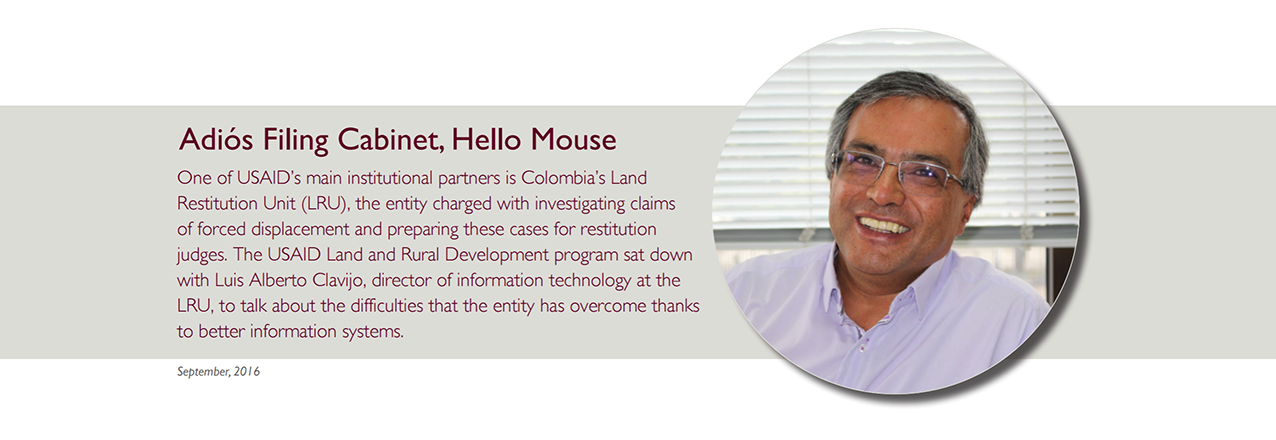One of USAID’s main institutional partners is Colombia’s Land Restitution Unit (LRU), the entity charged with investigating claims of forced displacement and preparing these cases for restitution judges. The USAID Land and Rural Development program sat down with Luis Alberto Clavijo, director of information technology at the LRU, to talk about the difficulties that the entity has overcome thanks to better information systems.
What was the main challenge with the former system for completing tasks related to land restitution?
When the LRU was formed, we didn’t have time to design methodologies or to really test tools before putting them into action. So our IT team had to prioritize the ones we wanted to develop. Everything had to be created on the fly.
When did LRU start partnering with USAID?
In 2013, we began talking about the projects that required assistance. One of the first was the ethnic module. Then we began discussing systems for managing restitution claims and the post-ruling phase.
How has this partnership changed the way LRU approaches land restitution?
The improvement has been great. Colombia’s official information on restitution comes from the data captured in our system. Before, we couldn’t do this, since we didn’t have everything in the system; to get statistical data, we had to call the regional offices, which made the process more complicated. Today, we do it differently. The data that is in the system is the data that counts. And everyone knows that. USAID helped us finance this work. So what we have on our website—all that information on claims, rulings—comes from the modules USAID helped us develop.
With these new systems in place, how has your work life changed?
These systems represent a huge responsibility for me, since official data come from the office of technology. Many factors are involved in the system’s functioning—a server could go down, and so on—so you have to be on top of a lot of things at once. But on the other hand, when people ask for information on any specific theme, I can give it to them. In this way, my work has changed, because we’re able to respond to these requests. We get requests from the Public Prosecutor’s Office, the Senate, and the Presidency—from lots of people. And we always give them an answer. For me, it’s simpler now, since I know the information is there. The systems are a great tool not just for the office of technology but for the entire LRU. And in the medium term, they’ll be a great tool for other institutions as well.
Has the development of these systems affected or improved relationships within the LRU?
It depends on how you look at it. In the past, an information system meant a registry, and that was it. There was no further management. But here, we want to be able to track any restitution case from start to finish. This implies having controls within our systems—and of course, people don’t like to be controlled.
Some regional offices were resistant in the beginning, because staff were being told, “you need to comply with the terms.” They felt monitored. From a user’s perspective, having to do things this way can feel a bit tense. But later it becomes a necessity, because users no longer have to worry about the little details—the system helps guide them along. They no longer have to think about the mechanical aspects and can focus on the more substantial part of their jobs. It is a relationship going through phases. People are used to having their hard-copy folders—they need to feel something in order to do it—and changing that isn’t easy. But I think that in a year, there will be a cultural change within the entire LRU around information management.
Where do you see land information going in the future?
I hope that with all of this work we’re doing in terms of information sharing, the institutions modernize—because part of what is happening today is due to the fact that before, they weren’t careful with information. You can see for yourself: there’s no official information for many land parcels. That needs to change. Today, we can’t use the excuse that Colombia lacks the appropriate technology. We have just as much technology as any other developed country. It’s an issue of will, of having a vision of how things should be. We need to show that things can be done differently. For instance, as we are doing with the Land Node project—getting all those entities to coordinate, to share information, to show that it can be done without too many complications. USAID’s support has been very important in this regard.


